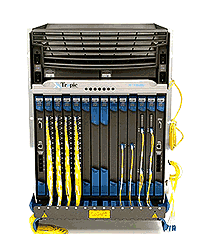Has it been hibernating? Retrenching? Whatever it is, the metro startup's ready to show its wares publicly
May 3, 2002

This time last year, Tropic Networks Inc. was the talk of the town up in Ottawa. As one of Canada's most richly funded startups, it was widely expected to make a major splash in the metro market (see Tropic Reveals Investors and Tropic Lands $10M).
When telecom took a nosedive, Tropic took a powder (see Tropic Joins Canadian Cutback Crew). Despite claims to be on plan, it quietly slipped off the general radar over the past few months.
Now it's back, with 150 employees (25 short of the 175 it had before its layoff), with its initial product rollout slated for May 27, and with plans to show its metro products for the first time publicly at Supercomm 2002.
Tropic's main product, the TRX-24000, is an optical edge system that combines DWDM with optical add/drop multiplexing and wavelength management software. It provides up to 96 wavelengths in a box with a capacity of 1.28 Gbit/s to 3.5 Tbit/s.  Tropic says it facilitates Ethernet and wavelength services without the need for multiple Sonet ADMs and access equipment (besides DWDM gear). The startup boasts that its box can save carriers more than 50 percent on the cost of housing, maintaining, and operating traditional Sonet gear.
Tropic says it facilitates Ethernet and wavelength services without the need for multiple Sonet ADMs and access equipment (besides DWDM gear). The startup boasts that its box can save carriers more than 50 percent on the cost of housing, maintaining, and operating traditional Sonet gear.
Industry analysts maintain that the metro edge is where carriers will be compelled to start spending in order to accommodate a growing range of data services, particularly Ethernet services.
"Metro Ethernet services are a key driver of optical capacity," says Russ McGuire, chief strategy office at consultancy TeleChoice Inc. If just 5 percent of U.S. businesses adopt it, his firm estimates, that will saturate metro capacity by 2005.
Sources say carriers are using venues like the upcoming Supercomm 2002 tradeshow in Atlanta to investigate products that will add capacity for emerging metro services, even if they're not buying just yet. "Supercomm will be full of tirekickers, not buyers. But we need tirekickers to get buyers. I think Supercomm is good news for 2003," says Frank Dzubeck, president of consultancy Communications Network Architects (no Web site).
Tropic faces a range of competitors. Leading the pack are suppliers that, like Tropic, are making packet-based optical edge gear for metro use, including Atrica Inc., Extreme Networks Inc. (Nasdaq: EXTR), and Luminous Networks Inc.
Tropic also faces competition from vendors that base their optical edge hardware on circuit switching instead of Tropic's packet-based approach (see A New Optical Taxonomy, page 7). There's a formidable list here, including Appian Communications Inc., Ciena Corp. (Nasdaq: CIEN), Lucent Technologies Inc. (NYSE: LU), Nortel Networks Corp. (NYSE/Toronto: NT), and Redback Networks Inc. (Nasdaq: RBAK), to name just a few.
Some experts say the outlook for these circuit-switched vendors may be a bit better in the near term, since carrier networks now are based primarily on circuit switching. Carriers who don't want to make sizeable changes to their nets in the near future may opt for gear that builds on their existing tack.
Tropic seems ready to take its chances, though. Indeed, it seems ready to proselytize its position: In order to advance its cause, it is offering network design services and consulting as part of its overall package.
— Mary Jander, Senior Editor, Light Reading
http://www.lightreading.comFor more information on Supercomm 2002, pleasevisit: Supercomm Special
You May Also Like








